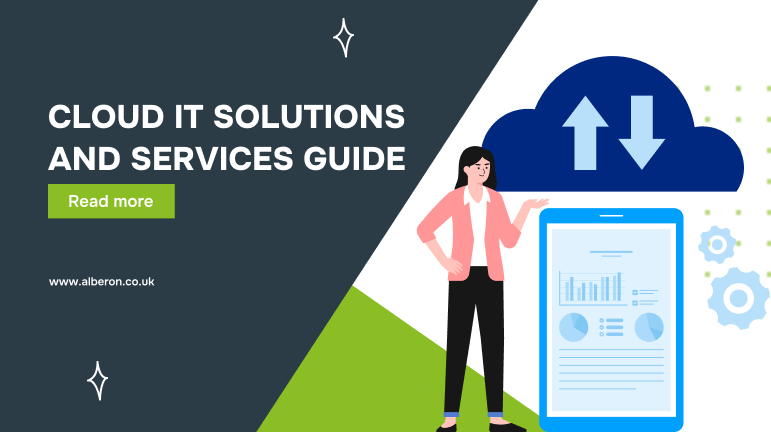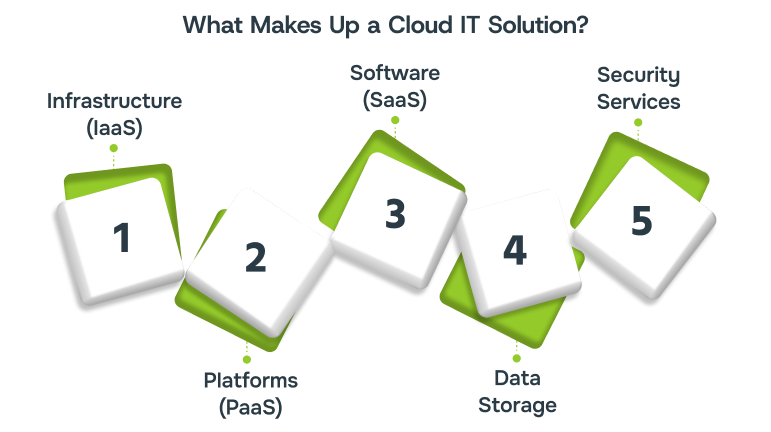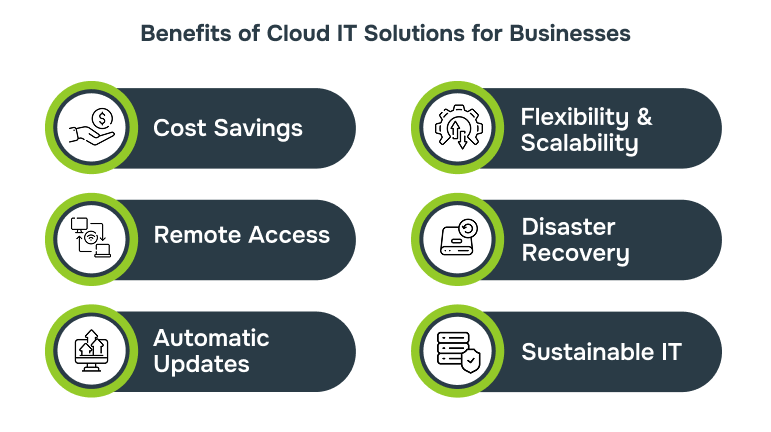Cloud IT Solutions and Services Guide
Unlock enterprise-grade cloud IT solutions for Oxford businesses. Schedule a consultation, explore Microsoft 365, and secure your data. Act now!

Still running critical operations on outdated servers or juggling disconnected tools? You’re not alone, and the cracks are showing in missed deadlines, downtime, and rising IT costs.
That’s why 69% of companies have accelerated their cloud migration in the past 12 months, according to a techUK report. The reason? Cloud IT solutions offer a way to access infrastructure, storage, software, and support without the burden of managing it all on-site.
For small and mid-sized businesses, especially, the cloud isn’t just a technical upgrade; it’s a practical step toward resilience, flexibility, and long-term growth.
In this guide, we’ll walk you through what cloud IT services actually include, why they’ve become essential for modern operations, and how to approach your cloud journey with clarity, not confusion.
What Are Cloud IT Solutions?
You’ve probably heard the term “cloud IT solutions” in meetings, vendor proposals, or industry articles. But what does it actually mean for your business?
A cloud IT solution is any technology service, such as data storage, servers, software, or security, delivered over the internet instead of being hosted on your premises. You access what you need through a secure connection, while your cloud provider takes care of the infrastructure, maintenance, and updates.
Now that we’ve defined what cloud IT solutions are, let’s look at what they actually include and how they come together to support your business operations.
What Makes Up a Cloud IT Solution?

Cloud IT includes a range of services that go beyond just file storage:
- Infrastructure (IaaS): Scalable servers, networking, and storage
- Platforms (PaaS): Development and deployment environments for apps
- Software (SaaS): Business tools like CRMs, email systems, or finance apps
- Data Storage: Cloud-based storage that grows with your data
- Security Services: Built-in encryption, access control, and compliance support
Understanding these components also helps highlight how cloud solutions differ from the traditional, in-house IT systems many businesses are still using today.
Cloud vs. Traditional IT: What’s the Difference?
With traditional IT setups, you purchase physical servers, install software locally, and manage everything internally. This often requires large upfront investments and ongoing maintenance.
With cloud IT, you only pay for what you use. There’s no need to purchase equipment or manage updates manually. It offers flexibility, faster setup, and fewer internal resource demands. This makes it easier to adapt to changing business needs without the lag of physical upgrades or downtime.
Here’s a side-by-side look at how the two models compare across key factors like cost, scalability, and maintenance.
| Feature | Traditional IT | Cloud IT |
|---|---|---|
| Infrastructure | On-premises servers and hardware | Hosted by third-party providers (off-site) |
| Upfront Costs | High capital expenditure (CAPEX) | Pay-as-you-go operational costs (OPEX) |
| Maintenance | Managed internally by in-house teams | Handled by the cloud provider |
| Scalability | Requires new hardware and setup time | Easily scalable with demand |
| Setup Time | Longer deployment cycles | Faster to deploy and configure |
| Updates & Upgrades | Manual, often scheduled and disruptive | Automatic and seamless |
| Access & Collaboration | Typically limited to office networks | Accessible from anywhere with internet |
| Disaster Recovery | Requires separate systems and backups | Built-in redundancy and recovery options |
Where Are Cloud IT Solutions Being Used?
Cloud adoption is growing across all industries:
- Retailers use cloud-based inventory and POS systems for multi-location control
- Healthcare providers rely on cloud platforms for secure, compliant data storage
- Consulting and legal firms manage client communications and files through cloud CRMs
- Startups and SMEs run operations, manage teams, and build products using scalable cloud services
Whether you’re adopting cloud to improve day-to-day operations or to support long-term growth, it’s important to understand the different types of cloud services available and how each one plays a distinct role in your IT strategy.
Types of Cloud IT Services
Not all cloud services offer the same level of control or functionality. Depending on your goals—whether it’s running applications, developing new ones, or simply accessing tools—you’ll encounter different types of cloud IT services. Here’s a breakdown of the four most common models:
Infrastructure as a Service (IaaS)
If you want maximum control without owning hardware, IaaS is your foundation. It provides virtualized computing resources over the Internet.
- On-demand access to servers, storage, and networking
- Scales up or down based on workload
- You manage the OS, apps, and data
- Suitable for businesses with in-house IT expertise
Platform as a Service (PaaS)
PaaS offers a ready-to-use environment for application development, with no infrastructure setup required.
- Ideal for developers building web or mobile apps
- Handles operating systems, databases, and runtime
- Reduces development time and complexity
- Great for testing, deploying, and scaling applications
Software as a Service (SaaS)
SaaS delivers complete software solutions via the cloud, ready to use, right out of the box.
- No installation or infrastructure needed
- Access from any device with internet
- Automatic updates and maintenance are handled by the provider
- Ideal for teams using tools like email, CRMs, or document editors
Function as a Service (FaaS) / Serverless Computing
FaaS lets you run small pieces of code without managing any servers, just write, upload, and trigger.
- Pay only when your function runs (no idle costs)
- Best for lightweight, event-driven tasks
- No need to manage infrastructure or runtime environments
- Ideal for businesses with unpredictable workloads or limited dev resources
While these service types explain what cloud solutions can do, it’s just as important to understand how they’re deployed.
Common Deployment Models: Which One Fits Your Business?
Cloud services don’t all operate the same way. Depending on how much control, flexibility, and security your business needs, the deployment model you choose can have a significant impact on cost, compliance, and long-term scalability. Here’s a look at the four most common cloud deployment models and where each one fits best.
- Public Cloud
In a public cloud setup, your infrastructure is hosted on a shared environment managed by a third-party provider like AWS, Microsoft Azure, or Google Cloud. It’s one of the most widely adopted models because of its affordability and ease of access. There’s no need to purchase or maintain hardware since everything is handled by the provider, and you pay only for what you use.
Used by startups, SMEs, and growing companies that need to move fast without heavy upfront investment. It is especially useful for businesses with standard workloads and no strict data compliance requirements.
- Private Cloud
A private cloud is a dedicated environment built exclusively for one organization. It can be hosted on your premises or through a trusted provider, offering complete control over data, security policies, and system configurations. Since it is isolated from other users, it suits businesses that prioritize privacy and regulatory compliance.
Used by mid-sized to large enterprises, particularly those in healthcare, finance, legal, and government sectors, where data protection and compliance are critical.
- Hybrid Cloud
The hybrid cloud combines elements of both public and private models. It allows you to store sensitive data and critical systems in a private environment while leveraging public cloud resources for general or high-volume tasks. This approach provides more control while offering scalability and cost efficiency where it makes sense.
Used by organizations that are gradually shifting to the cloud or that manage a combination of sensitive and non-sensitive workloads across departments.
- Multi-Cloud
A multi-cloud setup involves using multiple cloud providers, often to reduce risk, avoid over-reliance on a single vendor, or optimize performance across services. Businesses can choose the best services from each provider based on their unique needs, whether it’s cost, location, or functionality.
Used by global businesses and enterprise-level organizations that require a high level of flexibility and redundancy across different platforms.
No matter which deployment model you choose, the shift to cloud IT brings a range of practical advantages that directly impact how your business operates, grows, and adapts.
Benefits of Cloud IT Solutions for Businesses

Cloud IT solutions help businesses operate with greater efficiency, reduce infrastructure costs, and stay resilient in changing conditions. From easier collaboration to improved data security, the benefits apply across industries and business sizes.
- Cost Savings: Cloud IT shifts your spending from capital expenditure (CAPEX) to operational expenditure (OPEX). Instead of investing in servers and data centers upfront, you only pay for what you use. This makes budgeting easier and reduces overhead costs.
- Flexibility and Scalability: Whether you’re onboarding new users, expanding into new markets, or handling seasonal spikes, cloud services scale up or down effortlessly, without the need for extra hardware or long lead times.
- Remote Access and Collaboration: Cloud platforms support real-time access from anywhere, enabling teams to collaborate seamlessly across geographies. This is especially valuable in hybrid or remote work environments.
- Business Continuity and Disaster Recovery: With built-in redundancy, automatic backups, and geographically distributed data centers, cloud solutions ensure your data and applications remain available, even during outages or unexpected disruptions.
- Automatic Updates and Minimal Maintenance: Cloud providers handle updates, security patches, and system improvements automatically. This frees up your internal teams to focus on strategic tasks instead of routine maintenance.
- Environmental Efficiency (Sustainable IT): Cloud data centers are designed for high energy efficiency and resource sharing. By moving to the cloud, your business reduces its carbon footprint and contributes to more sustainable IT practices.
While the benefits of cloud IT solutions are clear and compelling, it’s equally important to understand the potential challenges that come with them, so you can plan with confidence and avoid surprises.
Challenges to Be Aware Of
While cloud IT solutions offer significant advantages, they’re not without trade-offs. Understanding the challenges upfront helps you plan better and avoid costly missteps during implementation or scale-up.
| Challenge | What It Means |
|---|---|
| Data Security & Compliance | Cloud providers offer strong security, but businesses must configure access controls and ensure compliance with regulations like GDPR or HIPAA. |
| Vendor Lock-In | Relying too heavily on one provider can make switching costly or complicated. Planning for flexibility early can reduce this risk. |
| Downtime & SLAs | Even top providers face outages. Review service-level agreements to understand uptime guarantees and support terms. |
| Migration Complexity | Moving to the cloud isn’t always plug-and-play. It may require reworking apps, managing downtime, or training teams. |
| Hidden Costs | Pay-as-you-go pricing can lead to unexpected bills. Monitor usage regularly and set up alerts or caps where possible. |
Being aware of these challenges is the first step, but making the right cloud choices from the start can help you avoid most of them altogether.
How the Right Cloud Solution Drives Better Business Outcomes?
Choosing the right cloud IT solution isn’t just a technical decision; it affects every part of your business, from costs to productivity to long-term agility. Here’s why it matters:
- Business Alignment: The right solution supports your business goals, whether it’s rapid growth, lean operations, or compliance. A mismatch can slow progress or create roadblocks.
- Optimized Costs: It’s not just about spending less; it’s about spending right. The right cloud solution ensures your budget goes toward capabilities that actually support your business outcomes. Instead of overinvesting in unused capacity or cutting corners on critical features, you get a setup that scales with your needs, avoids waste, and delivers measurable returns over time.
- Scalability on Your Terms: Not every solution scales the same way. The right choice allows you to expand easily without performance issues or re-architecture.
- Better Security & Compliance Fit: Different providers offer different levels of control, data residency options, and compliance tools. Picking one that aligns with your industry requirements can save future headaches.
- Long-Term Flexibility: The right cloud solution keeps you agile. It should support integration with other tools, allow for customization, and leave room for future transitions, like hybrid or multi-cloud setups.
How to Choose the Right Cloud IT Solution?
There’s no universal blueprint when it comes to cloud adoption. Choosing the right solution starts with understanding your business inside-out and asking the right questions early on. Here’s a step-by-step approach:
1. Assess your current infrastructure and needs
Start by reviewing what tools, systems, and workflows are already in place. Identify bottlenecks, manual tasks, and what you’d like to improve, whether it’s collaboration, performance, or cost.
2. Consider industry-specific requirements
Regulations, data residency, and access rules can vary by industry. If you’re in healthcare, finance, or legal services, ensure the solution meets sector-specific compliance and security standards.
3. Budget and internal capabilities
Be realistic about what you can manage in-house. Cloud solutions may reduce hardware costs, but you’ll still need the skills to manage configurations, integrations, or vendor relationships.
4. Evaluate vendor offerings and SLAs
Compare service levels, uptime guarantees, support tiers, and pricing models. Look beyond marketing materials, read the fine print, and understand what happens during downtime or performance dips.
5. Plan for scalability and integration
Your cloud environment should be able to grow with you. Make sure it integrates well with your existing tools and has room to adapt as your business evolves.
Questions to Ask Your Cloud IT Partner
Before you commit to any solution, it’s important to ask your cloud provider the right questions. These can help you assess fit, trust, and long-term support.
- What type of support is included in your plans?
Clarify what’s offered by default and what comes at an additional cost, especially for onboarding, troubleshooting, or scaling. - How do you handle data compliance and privacy?
Understand how the provider ensures compliance with laws like GDPR, HIPAA, or other local standards relevant to your business. - Do you offer ongoing monitoring or optimisation?
Ask whether they provide performance tuning, usage reviews, or automated cost-saving suggestions over time. - What’s your experience working with businesses like ours?
Look for industry-specific knowledge and examples of how they’ve supported similar clients in terms of size, sector, or technical requirements.
Alberon’s Approach to Cloud IT Solutions
At Alberon, we approach cloud adoption as a strategic business move, not just a technical upgrade. Our focus is on solving real problems with practical, scalable solutions that support both current operations and future growth. By aligning technology with business outcomes, we help organisations move to the cloud with clarity, confidence, and control.
- Business-first strategy
Every engagement begins with a conversation, not a proposal. We take time to understand your operations, user needs, data challenges, and compliance concerns. Whether you’re aiming to improve collaboration, reduce IT overheads, or modernise legacy systems, our recommendations are guided by what matters most to your business. - Tailored cloud architectures
We don’t believe in off-the-shelf fixes. Our team designs cloud environments that fit your specific infrastructure, application landscape, and growth trajectory. Whether you need public cloud agility, private cloud control, or a hybrid approach, we create solutions that are flexible, secure, and ready for scale. - Security and compliance are built in
Data privacy and regulatory compliance are central to our designs. We incorporate robust access controls, encryption, backup protocols, and audit readiness into every deployment. From GDPR to industry-specific standards like HIPAA or ISO, we help you stay protected without slowing down your operations. - Smooth migration and integration
We manage every stage of the migration process: planning, testing, deployment, and post-move validation. Our team ensures your systems continue to run smoothly during the transition, with minimal disruption to users. Integration with your existing platforms and workflows is part of the plan, not an afterthought. - Ongoing optimisation and support
Once you’re up and running, we don’t disappear. We provide ongoing performance monitoring, usage reviews, and cost optimisation support to keep your cloud setup aligned with your evolving needs. As your business changes, we help you adapt your environment to support new tools, teams, or workloads without unnecessary complexity.
Talk to the Alberon team about building a cloud IT solution that works for your business, now and as you grow. Contact us to get started.
Conclusion
Cloud IT solutions are no longer a future investment; they’re a present-day necessity for businesses that want to stay flexible, secure, and competitive. But with so many service types, deployment models, and vendors to choose from, making the right decisions can feel overwhelming.
That’s where working with the right partner makes all the difference.
At Alberon, we don’t just help you migrate to the cloud; we help you get it right. Whether you’re just starting out or looking to optimise an existing setup, our team works closely with you to design, deploy, and manage cloud solutions that genuinely support your goals.
Looking to explore the right cloud strategy for your business? Get in touch with the Alberon team for a tailored consultation.
Get in Touch Today:
Ready to Improve your Business Productivity
Get a trusted partner to navigate your digital transformation. With Alberon, you can ensure a smooth transition, clear communication, and peace of mind.
